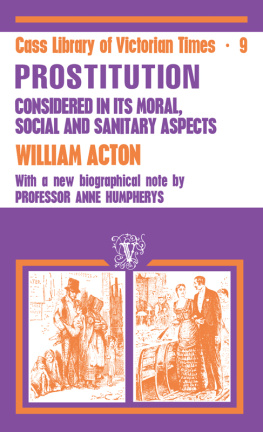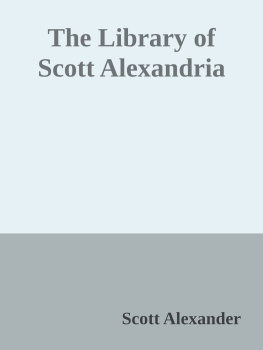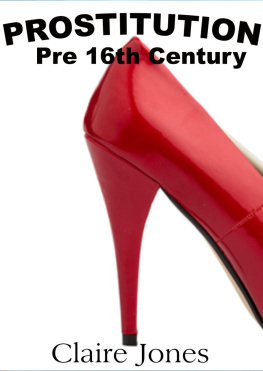A HISTORY OF PROSTITUTION
This scientific survey of the history of prostitution from antiquity to the twentieth century is one of the first comprehensive studies of this sociological phenomenon of our time. George Ryley Scott writes this treatise in reaction to the lack of literature on the subject at his time, dismissing the only volumes available as outdated, fragmentary, or prejudicedas they were often sponsored by reformist groups. Thus, Scott presents us with a refreshingly honest and nonbiased view of prostitution as it was throughout history up until its first publishing in 1936.
THE KEGAN PAUL LIBRARY
OF SEXUAL LIFE
THE HISTORY OF THE ROD
William H. Cooper
PHALLIC WORSHIP
Robert Allen Campbell
SEXUAL LIFE IN ANCIENT EGYPT
Lise Manniche
SEXUAL LIFE IN ANCIENT INDIA
J. J. Meyer
SEXUAL LIFE IN ANCIENT GREECE
Hans Licht
SEXUAL LIFE IN ANCIENT ROME
Otto Kiefler
AUTO-EROTICISM
Wilhelm Stekel
BUNDLING
Henry Reed Stiles
SEX AND SEX WORSHIP
O. A. Wall
THE HISTORY OF CORPORAL PUNISHMENT
George Ryley Scott
THE SCENTED GARDEN
Bernhard Stern
A HISTORY OF PROSTITUTION
George Ryley Scott

From The Nightless City, 1899.
A HISTORY OF
PROSTITUTION
FROM ANTIQUITY TO THE PRESENT DAY
GEORGE RYLEY SCOTT
First published in 2005 by
Kegan Paul Limited
Published 2013 by Routledge
2 Park Square, Milton Park, Abingdon, Oxon OX14 4RN
711 Third Avenue, New York, NY 10017, USA
Routledge is an imprint of the Taylor & Francis Group, an informa business
Kegan Paul, 2005
All Rights reserved. No part of this book may be reprinted or reproduced or utilised in any form or by any electric, mechanical or other means, now known or hereafter invented, including photocopying or recording, or in any information storage or retrieval system, without permission in writing from the publishers.
ISBN: 0-7103-1177-X
ISBN: 978-0-710-31177 (hbk)
British Library Cataloging in Publication Data
Library of Congress Cataloging-in-Publication Data
Applied for.
CONTENTS
SOME years ago, in connection with another work, I had occasion to dig deeply into the literature connected with prostitution. I was amazed to find that there was in existence no modern comprehensive study of a sociological phenomenon which is of the most profound significance. The only two works which can be called in any sense of the word exhaustive are those of Sanger and Lacroix. Both are hopelessly out of date. Sanger died in 1872; Lacroix's two-volume work was published in 1851. To-day these obese tomes are of little more than historical value.
There are other more modern works, but for the most part they are fragmentary, prejudiced studies dealing with special phases of prostitution, or with its relation to other sociological factors. In many cases they are issued by, or with the aid of, societies for promoting some reform or other, or with the object of alleviating an evil, and in consequence they are frankly propagandistic in tone and treatment. Their approach to the subject of prostitution is not a direct approachit is rather a consideration of the social evil as something which the writer is forced to include in an examination or a study devoted to some far worthier matter. This attitude colours the whole study and largely nullifies its force and value.
The reason for this is not far to seek. Prostitution is one of those subjects the discussion of which has always been either evaded altogether, or justified and excused by being linked up with some publicly applaudable social object or reform. Acton, an Englishman, writing in 1857, prefaced his work with a meandering, sanctimonious apology; Sanger, an American, wrote an introduction to his History of Prostitution which was a masterpiece of piaculous sophistry; Lacroix, a Frenchman, when he had completed his work, jibbed at letting his own name appear on the title page, and published the book under the pseudonym of Pierre Dufour. Even in these sophisticated days, when writers have surprisingly few scruples, most authors are averse to tackling a subject which is still generally looked upon as unsavoury.
Now, whenever I take up a book and find it prefaced with an excuse or an apology I am, rightly or wrongly, immediately prejudiced against both the book and its writer. I cannot disabuse my mind of the impression that an author who has to adopt such tactics will be afraid to deal with his subject adequately, or to tackle it fearlessly.
In submitting this study of prostitution I make no excuse for it; I offer no apology. I believe the need exists for a work surveying the whole field of prostitution, not with the jaundiced eye of the reformer or moralist, but with the dispassionate eye of the scientific observer.
GEORGE RYLEY SCOTT.
A HISTORY OF PROSTITUTION
IT IS a capital error to start an examination without defining exactly what one intends to examine. It is essential, before we can deal with prostitution, that we should know exactly what a prostitute is.
Writers on the subject in the past have differed widely in their attempts at definition. Paul Lacroix classed as prostitutes all women who were guilty of intercourse outside the married state; similarly Wardlaw, writing in 1842, defined prostitution as the illicit intercourse of the sexes. On the other hand the popular conception of a prostitute as a woman who temporarily loans the use of her body to a miscellany of men in return for money is obviously too narrow and restricted; as is also Webster's dictionary definition, to give up to lewdness for hire.55 In most cases essential factors to come within the meaning of prostitution are held to be immoral relations with at least two men contemporaneously, and for gain in each case.
It is as important to differentiate between a mistress and a prostitute as it is to differentiate between a married woman and a prostitute. The woman who lives with a man for an extended period, even though she forsakes him or is forsaken by him, and becomes the mistress of another man, is no more a prostitute, at this particular stage in her life, than a married woman who obtains a divorce and marries another man is a prostitute. She may have been a prostitute before or she may become one later, but this does not affect the point. Thus to include mistresses in the category of prostitutes is to give to prostitution too wide a scope. Actually these points may not be of any great practical importance in England; but in France and in certain other countries where prostitutes are inscribed, the distinction is one of considerable significance.
On the other hand, to limit prostitution to those who are entirely dependent for their livelihood upon promiscuous intercourse is at once too narrow and too illogical a definition. For these constitute but a fractional part of the vast army of women who indulge in promiscuous sexual relations as a sideline or a part-time occupation, and in many instances for other reasons than those connected with pecuniary reward. The distinction between the amateur and the professional is always conceded to be a distinction of money. In its ultimate analysis it is a meaningless distinction. It overlooks the fact that one may be willing to do something, whether distasteful or not does not matter, for some form of reward or recompense other than coin of the realm. Money is merely a token. The wealthy hobbyist or amateur has invariably some object other than pure altruism. The fact that there is no cash transaction does not necessarily mean the work, in popular parlance, is done for nothing.










